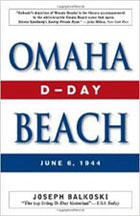| Plan a trip : |  |
 |
|
 |
Raymond S. HOBACK - 29th Division.
Bedford Boys Fallen - Raymond Samuel HOBACK never had a chance to reach 100 years old today. Instead, he sacrified his life for our freedom... Raymond may have made it out of his landing craft, but he never made it to shore. Others recall seeing his body in the water. Bedford also failed to make in on the beach. He was killed by an exploding 88mm shell. Their time in the battle could be measured in minutes... [American D-Day facebook] Read more...
[Posted: 2020-01-21 22:40:05]
Bedford Boys Fallen - Raymond Samuel HOBACK never had a chance to reach 100 years old today. Instead, he sacrified his life for our freedom... Raymond may have made it out of his landing craft, but he never made it to shore. Others recall seeing his body in the water. Bedford also failed to make in on the beach. He was killed by an exploding 88mm shell. Their time in the battle could be measured in minutes... [American D-Day facebook] Read more...
[Posted: 2020-01-21 22:40:05]
RIP - Robert GIGUERE - Navy.
It is with heavy heart we learn the passing of Mr. Robert GIGUERE, a veteran of D-Day (Normandy)... He was 93... Four days earlier, Giguere rode across the choppy English Channel toward the Normandy coast with the Sixth Naval Beach Battalion. When his carrier grounded on the beach, a Teller mine detonated from beneath and tore through the ship's hull, Killing several soldiers below deck... [American D-Day facebook] Read more...
[Posted: 2020-01-21 22:58:23]
It is with heavy heart we learn the passing of Mr. Robert GIGUERE, a veteran of D-Day (Normandy)... He was 93... Four days earlier, Giguere rode across the choppy English Channel toward the Normandy coast with the Sixth Naval Beach Battalion. When his carrier grounded on the beach, a Teller mine detonated from beneath and tore through the ship's hull, Killing several soldiers below deck... [American D-Day facebook] Read more...
[Posted: 2020-01-21 22:58:23]
| 1 - 2 / 25 news |
| WOLTERS HENRY H 1ST INFANTRY DIVISION |
Honored by Herman Wolters
[Posted: 2024-02-29 20:28:14]
| PALMER SAMUEL C 29TH INFANTRY DIVISION |
Honored by Jeffrey Palmer
[Posted: 2023-12-25 14:40:54]
| 1 - 2 / 135 messages |
 |
29th Division, 116th Regiment, 1st Bn., Command Group Group Critique Notes |
 |
| This is from the statement by Major Thomas S. Dallas, Bn Executive. The command group went shoreward in four boats from Princess Maud, these boats containing the Beachmaster and party for Omaha Dog Green, the Aid Station, Communications Group and Command Group. Major Dallas, command party made their start under auspicious circumstances. In lowering the Princess Maude boats from the davits of the HMS Empire Javelin, the command boat became stuck for 30 minutes directly under the ship's "head", and could go neither up nor down. During this half-hour, the bowels of the ship?s company made the most of an opportunity which Englishmen have sought since 1776. Yells from the small boat were unavailing. Streams, colored everything from canary yellow to siena brown and olive green, continued to flush into the command group, decorating every man aboard. "We cursed, we cried and we laughed," said Dallas, "but it kept coming. When we started for shore, we were all covered with shit." This was the only boat of the four which had any good fortune. Nine miles out, the boat with the Beachmaster foundered. All equipment was lost but personnel was dragged aboard the other three boats. Waves broke high over the boats and all personnel had to turn to and bail fast with their helmets to keep the boats afloat. The four boats went in just to the right of the draw leading to Vierville, drawing fire for the first time as they came to within 50 yards of the sand. The boats grounded at H plus 50, or 0720, 10 minutes behind schedule. Occasional bursts of arty fire broke around them, doing little hurt. They got no mortar fire. But bands of automatic fire from both flanks interlocked all along their boat front and they could see the bullets kicking up the sand. The water was 21/2 feet where the men unloaded. Ahead of them was a flat stretch of sand. As elsewhere, the auto fire did not bear on the boats until the ramps went down. Then it broke all around the debouching men. They got through the shallow water and across the small sand bar and the pool beyond it with relatively light loss. Then the ranging fire caught them and cut them down as they tried to cross the sands. Only one-third of the men reached the foot of the slope alive. "And they made it," said Dallas," because the men ahead caught the bullet which might have felled them and so saved them from the fire." The survivors worked into the gulleys and little niches in the cliff walls and once finding this cover, they ceased to move any farther toward the draw leading up to Vierville. The MG fire had closed in behind them. Snipers hidden in the slopes ahead made them keep down. Their force was spent. Dallas, taking his position in a small gully, had his 300 operator try to contact other forces up and down the beach. He could get only Lieutenant Colonel Metcalfe, who was behind a boulder, 100 yards away. The force stayed put. About 0830, Dallas, heard about Pingenot's boat team from "B" being on his right. He had already noted there were 25-30 Rangers disposed along the cliff base to his right. He told Hooks to gather all available men, move over to the right, scale the cliff and try to knock out the MGs on the right so that the main body could move up. Hooks and Pingenot, got about 60 men together, including the Rangers, and moved as ordered. They got up the cliff and hit the enemy positions short of Pointe de Rez. In a day-long fight, the knocked out the fortified house and cleaned out the entrenchments around it. (Later a Polish POW said there were 70 men defending this ground.) But the reduction of this resistance center took them until 1700 and they had not enough time to beat back and clean out other positions along the top of the cliff. In late morning, the same destroyer which had caught the other group farther to the right with its fire, began putting shells into Dallas? position, and kept it up until late afternoon. Dallas, sent up orange smoke; the destroyer then fire several rounds in the direction of the smoke. The men made sets of signal flags from their handker-chiefs and wig-wagged to the destroyer: "We are Americans. Cease firing." They got messages back on the ship?s blinker: "Surrender to the Americans." This tragic comedy continued through must of the day, with the result, according to Dallas, that he lost more men that afternoon to the destroyer than to the enemy. After the machine guns were finally stilled along the top of the cliff late in the day, the Beachmaster worked out of his niche and down the Beach until he got to a Navy radio where he succeeded in calling the destroyer off. It was then about 1700. The cliff top had then cooled off. Col Metcalfe rounded up all of the unwounded personnel in the immediate vicinity and headed toward the objective inland. Dallas, went on down the beach, looking for more men; he was to join the group near Gruchy. Covering both the 16th and 116th beaches, he collected about 50 men and at 2100, he started toward Gruchy, joining the rest of the Bn on the road beyond Vierville. There were about 250 men present for bivouac. |
||


